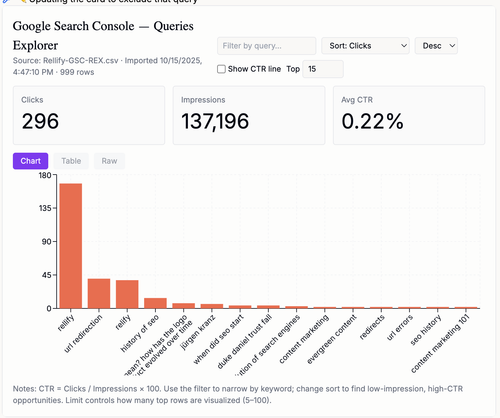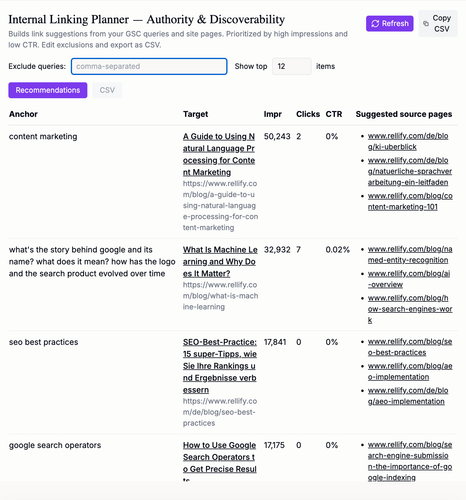Smart Cards: Content Marketing's AI Swiss Army Knife
Zuletzt aktualisiert am
veröffentlicht:
November 18, 2025

By Jayne Schultheis—What exactly is a smart card? Until recently, that term has referred to a plastic card with an embedded integrated circuit chip, like a credit card. Now, there's a new type of smart card—a secret weapon wielded by Rex, Rellify's expert AI agent.
A Rex smart card is an interactive, purpose-built mini app that puts data in a visualized form that makes it easy for you to explore. It's like a live widget (charts, tables, KPIs, filters) that you can click, sort, hover, or switch from tab to tab—without leaving the conversation. No building spreadsheets. No copying and pasting.
Would you like a sales pipeline snapshot from HubSpot showing deals by stage, forecasts, and close dates? Just ask Rex to create a smart card, and you'll have one in seconds.
If you want to introduce new fields or change the look of the results, just ask Rex and you'll instantly get a new smart card with those features.
You can create smart cards to:
- Visualize metrics with charts, KPI tiles, funnels, and cohorts.
- Explore tables by building sortable, filterable views of your data.
- Add controls by asking for date pickers, device/country filters, tabs.
- Pull live data by querying your uploaded files or connected online sources we’ve synced.
For content marketers, smart cards compress the time from “question” to “action,” as these living, clickable tools crunch the numbers and guide you on how to make the best use of that data. You can ask Rex to generate, customize, and maintain smart cards that track topics and reveal content gaps. Then, Rex can make auto‑suggestions for the next actions you can take.
Welcome to the smart card era
In plain English, a smart card is a tiny, focused application embedded right inside your workflow. Instead of scrolling through spreadsheets, or digging into long reports, you open a smart card—for example, “Content market share by topic”—and instantly see:
- A concise visualization (e.g., impression share by cluster).
- The top opportunities and risks auto‑ranked.
- Recommendations for one‑click actions like “generate brief,” “build internal links,” or “create a 30‑day update plan.”
Think of smart cards as being like a dashboard, but not as bloated. Each card is purpose-built for one decision, one job to be done, or one set of next steps.
Michael Rollins, Rellify's Head of Engineering, describes the difference this way:
“Everybody loves a good dashboard, but has your dashboard ever told you that you’re focusing on the wrong thing?
"I was working with Rex the other day. It gave me a smart card I requested about views on YouTube, but it immediately told me that I was focusing on the wrong metrics. It informed me that I needed to be focusing on user engagement metrics (percentage watched, average watch time, watch time hours). It offered to build me a new smart card with these metrics, which I happily accepted.”
Why are smart cards a game‑changer for marketing teams?
To fully understand smart cards, we'll have to place them in the context of Rex, our multi‑agent system that can distill market and proprietary data into actionable strategies, briefs and content workflows securely and at scale.
The Rex interface is similar to a chatbot. You type a question in the input field and Rex supplies the answer. Among the countless things you can ask Rex to do, one is to create a smart card. Smart cards are great problem solvers, because:
- They shorten the decision loop. Smart cards sit where you work (in your content platform or right in the conversation with Rex), so you go from question to answer to action in seconds.
- They unify data and workflow. A smart card can fetch data from sources you control (like Google Search Console exports or campaign tracking files) and use that data to update itself and provide suggestions for what you can do with the information.
- They make expert systems usable. Advanced techniques (topic modeling, entity coverage analysis, link graph mapping) show up as simple toggles and ranked lists. You get sophistication without the steep learning curve.
- They standardize excellence. Once a card encodes your best practice, the whole team can perform at that standard every time.
How do smart cards differ from dashboards and templates?
Dashboards tell you what happened, Rollins explains. Smart cards tell you what to do next, and you can use Rex to carry out those recommendations.
Templates are static. Smart cards are dynamic. They update with new data, guidance, and generated assets (like briefs, blog article outlines, or QA checklists).
Dashboards are broad. Smart cards are situational. Each card answers a single, high‑value question in seconds.
3 high‑impact smart cards for content marketers
If you're wondering how smart cards can overhaul your processes, here are some ways to get started
1 - Content market share by topic
The problem to solve: I want to know which topics we own, where we are losing ground, and what’s the fastest way to gain share?
Create a smart card: Tell Rex to create a smart card to show content market share by topic. Which topics do we own, where are we losing ground, and what’s the fastest way to gain share?
How it works:
- Upload Google Search Console data or sync Rex with your GSC account.
- Tell Rex to use the data to make a "Content market share by topic" smart card.
- In a few seconds, a smart card appears. It displays data on impression/click share vs. the market. It also can cluster queries by topic, and flag “rising rivals” and cannibalization problems.
Why it matters: It converts a sprawling SERP analysis into a prioritized to‑do list with clear ownership and projected lift.
Here's a sample of a smart card that we got from Rex. We asked it to pull the GCS data and from here, you can use that data within Rex to inform every step of your marketing. REX will even suggest ways you can use the data and suggest next steps.

2 - Competitor gap hunter
The problem to solve: I want to know which questions and subtopics our rivals are covering that we’re not?
Rex will create a smart card to do this and it will:
- Compare your topic coverage against a set of competitor pages.
- Extract unaddressed entities, FAQs, and examples.
- Propose net‑new article concepts and companion assets.
Why it matters: You can stop guessing about what content to produce and start filling the highest‑value gaps first.

3 - Internal link architect
What the smart card answers: What are the best internal links to add today for authority and discoverability?
How it works:
- Visualizes your cluster graph.
- Proposes links from strong hubs to pages needing support.
- Generates suggested anchor text aligned with user intent and entity coverage.
Why it matters: Internal links are controllable leverage. This card turns them into a daily habit.

What kinds of data can a smart card use?
Great data in equals great data out. To make the most of smart cards, you'll have to either import it into your Rex account or tell Rex where to find it. Here are some examples of the types of data a digital content marketer might need.
- Performance signals. Google Search Console exports (queries, pages, CTR), analytics snapshots (sessions, conversions), and campaign UTMs.
- Content artifacts. URL lists, article metadata, publication dates, and current headings.
- Knowledge sources. Brand voice guidelines, product glossaries, and SME Q&A notes.
- Competitive sets. A curated list of rival URLs and their on‑page entities/FAQs for comparison.
Governance and quality: How smart cards keep you safe
Smart cards maintain governance and quality through three complementary mechanisms. By design, they assign roles and gates (draft, review, approve) so human oversight remains central even as workflows accelerate. Each card will show its decision rules, making the logic transparent and auditable.
For example, "We flag pages when CTR falls below site median and queries are missing three or more required entities." When cards propose updates to titles, schema, or internal links, they package these suggestions into reviewable tasks or briefs rather than implementing changes automatically, preserving the ability to reverse or refine recommendations before they go live.
FAQ
What’s the main benefit of smart cards for content teams?
They convert complex data into guidance on what actions you should take, so you can ship better work faster with less context switching.
Do I need a full BI stack to use them?
No. You can start with lightweight exports (GSC CSVs, analytics snapshots), then add sources later.
Can smart cards generate content?
They generate structured briefs, outlines, and checklists that keep writers stay on‑brand and on‑topic. Rex can also draft starter copy if you choose, but human review remains part of the AI integration workflow.
How do smart cards scale across teams?
Once you like a card, you can reuse it. Your best practice becomes the team’s default—no extra training required.
Smart cards are the bridge between AI and marketers
Smart cards are the agentic AI bridge between data and deliverables. They put your KPIs, competitive signals, and brand standards into a simple, repeatable workflow that any marketer can run. The payoff is compounding: you'll end up with clearer priorities, tighter briefs, faster iterations, and measurable lifts in visibility and conversions.
Ready to see it in action? Ask a Rellify expert to have Rex build your first smart card today!


